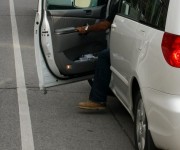City bicyclists know the dangers of the door zone: In this three feet of road closest to parked cars, it’s not uncommon for careless drivers (or cops — see below) to swing their doors open without looking. The ensuing collision of metal, glass, and flesh can be disastrous, and since most bike lanes are nestled up against parked cars, the door zone also effectively cuts many bike lanes in half. There are a number of better ways to design bike lanes, but redesigning a street costs money — something most cities are short on these days.
In bike-centric cities like San Francisco, the door zone can be a big problem. The San Francisco Municipal Transportation Agency (SFMTA) notes that dooring is the second most common cause of injury while biking, so the agency set out to do something about it. Their economical solution involved painting a few lines to alert riders to the extent of the door zone. From the San Francisco Streets Blog:
On sections of Polk Street, the SFMTA has painted in a batch of T’s in the bike lanes that are supposed to guide bicyclists away from the door zone. While the treatment seems to be an improvement over typical door zone lanes, it also highlights how little street width is available for cyclists to ride safely.
Streetsblog San Francisco says studies performed by the SFMTA show the added lines have increased the average distance from the curb cyclists ride from 10.3 feet to 10.9 feet. While that may not seem like a lot, it was enough that the number of cyclists riding in the door zone on Howard Street, one of the trial streets, dropped from 24 percent to 10 percent. Riders on Polk Street moved from an average 10 feet to 10.4 feet from the curb, and door zone cyclists dropped from 41 percent to 30 percent.
The ideal option would be to give cyclists more of the road; cycle tracks do this while using parked cars to keep car traffic out of the bike lanes. But those require more money to implement. So until cities reconfigure streets to accommodate cycle tracks (or even wider bike lanes), these cross-hatches may be the best hope for keeping cyclists safe from the menacing thwack of the door zone.



